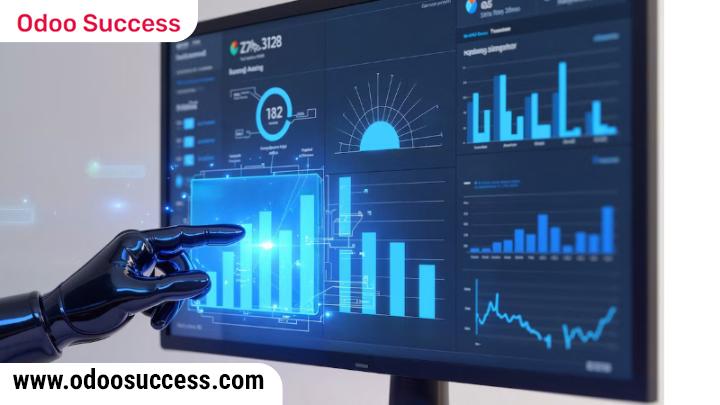Odoo Success: A Roadmap to Business Transformation with ERP
In today’s hyper-competitive world of business, the future is not just about having innovative ideas and hard work, but also about efficiency, data-driven decisions, and smart automation. For many companies around the world, the key to success has been one powerful tool, Odoo.
Odoo success stories are increasingly common amongst start-ups, SMEs, and large enterprises. Odoo is a modular ERP system that has helped companies around the world optimize business processes, improve production, and increase profitability. But what does Odoo success mean? And how do companies do it?
In today's article, we will discuss a framework for Odoo success, a run-down of common stock points and why or why those challenges may have happened and provide some examples from companies across multiple industries on how they have chosen Odoo to help them succeed in their business.

What Is Odoo?
Odoo is an open-source ERP (Enterprise Resource Planning) platform that is a collection of integrated applications that help manage business functions such as:
- Sales and CRM
- Inventory and supply chain.
- Accounting and Finance
- HR and Recruiting
- Manufacturing and Project Management
- Marketing Automation
- E-commerce and website building
Odoo is different from legacy ERP systems by being modular and scalable, allowing companies to start small and scale-up with a few modules at a time. Odoo has over 7 million users around the world, confirming that it is a flexible, cost-effective ERP solution for all business sizes.

Key Ingredients of Odoo Success
While the capabilities and pricing of Odoo are compelling, genuine Odoo success depends on a combination of strategic and operational factors. Following is an overview of the factors you need to be successful with an Odoo implementation:
Defining Clear Business Goals & Requirements
It is important you define your business goals before you start implementation. What issues are you trying to solve? What processes do you want to streamline? Want to fix your inventory accuracy or want to automate your invoicing? Whatever it may be, it is essential to have clear goals that align your organization and Odoo’s capabilities right out of the gate.
Picking the Right Modules
Using Odoo the right way requires reaching a proper set of modules from the hundreds of options available through official or community offerings. Determining the correct combination of modules depends on your industry, size, and specific requirements. A retail organization could consider POS and inventory most important, while a manufacturer could focus on MRP (Manufacturing Resource Planning), supply chain and quality control.
Customization & Integration
Odoo gives you the ability to customize and integrate modules which allows you to push the boundaries of the application within your organization. Odoo modules can be customized, as well as integrated with other applications like Shopify, PayPal, Google Workspace, or external CRMs. Either way, if you customize without thinking long term, especially with no clear method for simplifying your business processes, it can make Odoo complicated. On the other side, be smart about customization so that the software grows to support your process without it becoming impossible to manage.
Data Migration and Testing
Legacy data migration into new ERP systems is often one of the hardest points of the implementation. To ensure Odoo success, the data should be cleaned, validated, and evaluated in a staging environment before going live process.
User/Employee Training and Adoption
The best ERP system can still fail if employees do not know how to effectively use it. Proper training, careful process documentation, and ongoing support are crucial for ensuring that the users are comfortable and confident navigating the platform.
Post Go-Live Support & Iteration
After the implementation is done and you go live, success does not stop. It is important to monitor system performance, obtain feedback from users, and continuously improve. As the business changes, ERP should also change.

Common Challenges and How to Overcome Them
Despite Odoo being user-friendly and very customizable, implementing an ERP system can be complex. Below are a few common issues and how businesses can overcome them.
1. Underestimating Time and Resource Requirements
ERP projects are rarely completed within the periods that organizations initially expect. Frequently, this is due to misestimating complications that arise during design, configuration, testing, and training. Solution? Develop a realistic project plan and include adequate buffer time for user acceptance testing and all other stages like training.
2. Disconnected Teams
If there is a lack of communication and collaboration between departments, phases of implementation could be derailed. Solution? Include all key stakeholders from all teams at the most relevant times early, and throughout the entire project.
3. Scope Creep
Trying to implement too many desired functions simultaneously risks the timeline getting pushed back with additional iterations and apply holds on project definition. Solution? If an organization initially focuses on the core functionalities, with gradual expansion, there is less chance of a project timeline piling up, because users have had a chance to experience the new ERP.
4. Losing Employees
When employees are not adequately trained for the new way of doing things due to fears or uncertainty, it will be difficult to convert them as successful users. Solution? Include employees as part of the process, dig and discuss the hesitations and responses they may have, and apply a successful onboarding.
Industries That Thrive with Odoo
We can examine various industries to see how they have found success with Odoo by aligning its features with their operating processes.
Manufacturing
Odoo's MRP module provides manufacturers with detailed production planning, BOM's, work orders, and quality assurance. Firms benefit from real-time data as to where inventories are, and production timelines are predictable.
Retail and E-Commerce
Odoo integrates physical and digital retail operations from inventory control, POS systems, and online storefronts. Businesses are able to consolidate and report on customer data, track sales, and automate marketing in one integrated system.
Healthcare
Medical services providers utilize Odoo to facilitate appointment scheduling, document patient information, and invoice clients. By using custom modules Odoo can also integrate with labs and diagnostic processes while maintaining seamless operations across departments.
Professional Services
Consulting and professional services organizations utilize Odoo to document time, project completion, invoicing, and profitability tracking of client work or project work. The combined use of project management, timesheets, and CRM support in this industry is compelling.
Logistics and Distribution
Odoo’s inventory, purchasing, and fleet management modules are well-suited to facilitate distributors with automation of supply chain functions and monitoring stock or inventory levels to fulfill customer orders accurately and efficiently.

Measuring Odoo Success: What Metrics Matter?
To evaluate the success of your Odoo implementation, track a few KPIs:
Processing time reductions (ex: invoice generation, order delivery)
Order accuracy increases.
Decrease in the cost of holding inventory.
Increase in customer satisfaction.
An increase in employee productivity
Faster decision-making achieved through real-time dashboards.
Tracking those metrics for some time enables you to adjust your system and measure ROI.
Getting future-ready with Odoo
ERP systems are long-term investments. The adaptability of the Odoo platform to future changes will be one of the biggest contributors to Odoo success — whether those changes are business growth, regulatory updates, and changes to customer preferences.
Odoo improves performance, features, functionality, and UX every year in its yearly release. Additionally, Odoo offers both on-premise and cloud deployments, in addition to the deep and widespread global Odoo community emerging to build and support the Odoo experience.
Conclusion: Start Your Journey Toward Odoo Success
Achieving success with Odoo comes from more than just software. It comes from aligning technology to strategy, people, and processes. With the right approach, expert advice, and a continuous improvement plan, Odoo will transform your business from the 'inside' out.
If you are ready to start your Odoo journey, or you would like to see how we can help you improve your existing Odoo system, the Odoo success team can help you.
We provide consultation, implementation, customization, third-party integration, and support services with the goal of ensuring businesses like yours can obtain the most from their Odoo system and achieve success.
Frequently Asked Question
1. What is Odoo success, and how does it differ from using Odoo?
Odoo success means successfully implementing and continuously optimizing your Odoo ERP in a way that provides the business value you are looking for — more efficiency, lower costs, improved decision-making, and the like. Just using Odoo does not mean that you have achieved success; you must continuously plan, deploy, customize, train, and improve your system. Otherwise, you will not be fully leveraging Odoo to create and deliver business value.
2. How long does it take to get Odoo to a successful place after implementation?
This varies based on how large or complex your business is and how many modules you are implementing. A basic implementation on Odoo can take 4–6 weeks, while larger Odoo implementations that require significant customization could take several months. However, the "success" of an Odoo implementation usually spans well past your Go-Live date and every business will go through a period of optimization and change management for several months afterwards.
3. Can small businesses achieve Odoo success, or is it just for large corporations?
Yes!One of Odoo's main advantages is its modular AND scalable functionality, which is great for small and medium businesses. Many SMBs bite off the Odoo solution piece at a time and achieve success with a few of the more common modules (Sales, Inventory, and sometimes Accounting), and then they add modules as businesses grow.
4. What are the biggest barriers to achieving Odoo success, and how can these barriers be avoided?
The largest barriers we have seen include implementation underestimations, lack of internal expertise, poor data migration and user adoption. These issues can be avoided or mitigated by hiring a good Odoo consultant with extensive implementation system experience. As well as setting expectations, involving the right people early, and training support.
5. Is it required to customize Odoo to achieve Odoo success?
Not always. In most cases, businesses find that the core Odoo modules offer a basic solution to their requirements. Businesses may also require some simple customization to meet the needs of a specific process. In the case of Odoo success, the more you can minimize customization, the better you will be able to assist with your future upgrades. The other negative of over-customizing is higher costs and ongoing maintenance.